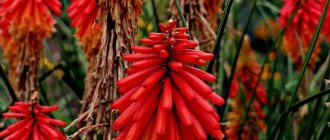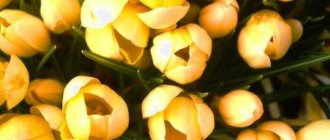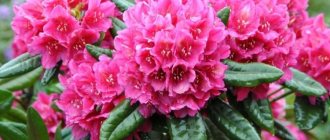Croscomia or Japanese gladiolus (Montbrecia) is a perennial from the bulbous family. The translation of the name from Greek means the smell of crocus. This strikingly beautiful flower has tall (1-1.5 m) intensively arranged stems with great branching. Its smell can be confused with saffron. The appearance of the stem with buds is similar to gladiolus, which is related to it, as are irises and crocuses.
Small flowers (4 cm), shaped like a funnel, can be observed for quite a long time: from mid-summer to mid-autumn. All gardeners strive to have some unusual plant, but Montbretia does not serve this purpose very often. There are not very many requirements for care and maintenance. When growing crocosmia in open ground, it is necessary to follow certain agricultural techniques that will allow you to have this beautiful flower on your home plot. With its help you can create beautiful unique design compositions.
Description and features of crocosmia
A flowering plant native to South Africa is crocosmia. There are many varieties, but the most popular variety is Lucifer, which is distinguished by its bright red color and tall peduncle. Among gardening enthusiasts, there are different names for the crop, but the most commonly used are montbretia, tritonia and Japanese gladiolus. Dried flowers emit a light and pleasant saffron aroma.
A tropical perennial plant of the Iris family reproduces by bulbs. The graceful long leaves are sword-shaped and grow up to 60 cm in length. The structure is corrugated with longitudinal stripes. Arrangement in spreading bunches. A thin tall peduncle grows up to 1 meter. At the top of the shoot there is an inflorescence of spikes, numbering up to 40 buds, which open gradually from bottom to top.
The variety of varieties shows variations in petal colors from light yellow to brick red. Each flower, when opened, reaches 5 cm in diameter.
Crocosmia is often confused with freesia due to the similarity of the stems or with lily due to the shape of the flower.
The first buds begin to open by mid-summer and continue to delight the gardener until frost. The fruit is a round box filled with rather large seeds of a rich brown color.
Features of care
The flower needs to be provided with moderate root watering throughout its entire life cycle. It is enough to water the flower 1-2 times a week. If it rains systematically, watering stops.
Top dressing
Ifeyon flowers - planting and care in open ground
If the soil was properly fertilized before planting, then there is no need for frequent fertilizing. If not, then fertilizers must be applied systematically, every 10 days. During the budding period, to stimulate flowering, fertilizing is necessary to saturate the plant with potassium. If everything is done correctly, the flower will definitely thank its owner with its spectacular appearance and pleasant aroma.
Preparing for winter
In regions where the air temperature drops below −20 °C, according to the general description of the plant, the bulbs must be removed from the ground in the fall. This is done around the beginning of October. After digging, they are dried and placed in a cool, ventilated place with an air temperature of about 10 ° C.
Important! In regions with warm winters, flower bulbs do not need to be dug up. It is enough to cover it with a layer of mulch and cover it with cling film on top.
Types of crocosmia
In nature, Montbretia is represented by more than 55 varieties; only a small part is cultivated. Let's look at the most common of them.
Massonorum
It is highly resistant to cold and is optimal for growing in northern regions. A low-growing bush 0.6-0.8 cm high with sword-like leaves with a ribbed structure. The stem of the peduncle grows upward and, at the point where the inflorescence begins, turns horizontally, that is, parallel to the ground.
Golden
The species is the ancestor; it was brought from the South African tropics. Flowering time is September. Flowers, depending on the variety, can be colored in orange, yellow and red shades.
Potsa
It grows in the marshy soils of the African continent. In the garden, choose shaded areas with poorly drying soil. The leaves of the plant are thin and smooth, the flowers are small.
Paniculata
The bush, one and a half meters high at the base, is decorated with a bunch of corrugated leaves of a light green hue. Compact inflorescences of bright orange color appear in the second half of June. This species is the earliest of all members of the family.
Ordinary
One of the first garden hybrids created at the end of the 19th century. The height of the plant reaches a meter. The greenery of a light shade consists of erect plates, narrow and graceful. The inflorescence includes small funnel-shaped buds. The first brushes appear in mid-summer.
Caring for crocosmia in the garden
You need to care for crocosmia in almost the same way as gladioli. Watering should be plentiful and carried out once every 7 days. When the water is absorbed into the soil, it is recommended to loosen it to break up the crust that has appeared.
For normal growth and development, such a flower must be systematically fed. If you planted crocosmia on soil rich in nutrients, then you can do without fertilizing. But if the soil is poor, then feeding the plants should begin after the second true leaf has formed, and this procedure should be carried out once every 1.5 weeks. To do this, it is recommended to use mullein infusion (take 1 part mullein for 10 parts of water), as well as complete mineral fertilizer (2 grams of product per liter of water). During budding, such a plant needs fertilizer containing a large amount of potassium.
Caring for crocosmia is not at all difficult. As for diseases and pests, if you follow all the rules of agricultural technology, you will not have problems with this plant.
How to propagate
It was already mentioned above that such a flower can be propagated by seeds, and the vegetative method is also used for this. You can read above about how to grow crocosmia from seeds. For vegetative propagation, gardeners use division of corms. Every year, about one adult corm grows to 5 children, which begin to bloom the next year. At the same time, the parent corm continues to grow children. In this regard, when growing such a flower, it should be taken into account that it will be necessary to systematically divide and plant the corms.
Division is usually done after the planting becomes very dense. To do this, in the spring you need to dig up the corm and carefully tear off the children from the parent bulb, which are then planted in a permanent place. At the same time, it is recommended to plant children in the same time period as planting seedlings, namely, in the last days of April or the first days of May. If you wish, then to begin with, the separated children can be planted in individual pots, where they will grow until May or June. And then they will need to be transplanted into open soil.
Pests and diseases
Crocosmia is highly resistant to diseases and harmful insects. But if you care for it incorrectly or allow fluid to stagnate in the root system, then it can be affected by diseases such as:
Fusarium
The leaf blades of an infected bush begin to turn yellow, they gradually dry out and fall off. There is also curvature of peduncles and deformation of flowers, and a change in their color is observed.
Gray rot
A fluffy gray coating appears on the surface of the corms.
Herbaceousness (jaundice)
First, the tips of the leaf blades turn yellow, and then the leaves appear straw-colored. As a result, the bush dies. This disease is viral and is carried by leafhoppers.
If the bush is infected with fusarium, then it should be treated with a fungicidal agent. It is recommended not to fight gray mold, but to prevent its occurrence. If a bush is affected by jaundice, then it will be impossible to cure it, because an effective remedy for this kind of disease has not yet been found. For preventive purposes, in order to prevent infection of crocosmia, it is recommended to plant it exclusively according to the rules of agricultural technology. Before sowing or planting, it is also necessary to carry out mandatory treatment of planting and seed material with a solution of manganese potassium (1%). It is also necessary to systematically change the planting location of such a plant.
Crocosmia can especially suffer from harmful insects such as thrips, mole crickets, and spider mites.
Medvedki
Such insects eat corms, and they lay their offspring in the ground at a depth of ten centimeters. In order to destroy them, it is recommended to make special traps. At the beginning of the autumn period, you need to dig a hole half a meter deep and put fresh horse manure in it. In order not to forget where this place is, put a sign. After some time, the mole crickets present in the soil should hibernate in the manure. All you have to do is dig a hole and destroy them.
Thrips
They suck plant juices from crocosmia. In the affected specimen, discolored spots, stripes or streaks form on the leaf blades. The shoots become crooked, the leaves fall off, and the flowers become less attractive. To get rid of such insects, you should treat the bush with such means as: Fitoverm, Karbofos, Agravertin, Actellik or Confidor, and you must follow the recommendations given in the instructions.
Spider mites
They settle on plants only during a long period of drought. These pests also suck out the plant juices from the flower. You should also remember that such pests are carriers of viral diseases that cannot be cured. To destroy such insects, you should use the same drugs that are recommended to combat thrips.
Popular varieties and use in garden design
Crocosmia is popular among hobbyists and landscape designers. Airy inflorescences of bright colors decorate the flowerbeds of almost every plot, so the work of breeders does not stop. To date, more than 4 hundred varieties have been bred.
Let's look at the best of them:
| Variety | Height, cm | Description | Application |
| Emily Mackenzie | 60 | Low growing bush. The flowers are brick orange with a bright spot in the center. | Used in group compositions in mixed flower beds. Combines with crops that bloom in late summer. |
| Lucifer | 150 | Frost-resistant variety. Large blood-red flowers are deservedly recognized as one of the most beautiful. | Cut, used in bouquets and in exterior design as background plants. |
| George Davidson | 70 | Juicy flowers of an amber-yellow hue look good against the backdrop of dark greenery. | Ideal for tabletop compositions. |
| Red King | 90 | The buds are red-orange with a bright center. | Grow as a houseplant. |
| Spitfire | 60 | Orange inflorescence on a delicate stem. | In gardens and on window sills. |
| Tangerine Queen | 120 | They are grown in flower beds. |
Given the long flowering and bright color of the buds, the crop is widely used for the design of exterior compositions. As a rule, the bush is planted in the background, where the lower green part serves as the background, and the inflorescences on graceful legs add air and completeness to the design.
Pests and diseases
Planting and caring for Crocosmia Lucifer and other varieties necessarily includes the prevention of diseases and pests, which often affect both the outer part of the plant and the corms:
- fusarium - massive yellowing of leaves, their drying and falling, deformation of stems, loss of natural color in flowers;
- gray rot - the appearance of gray spots with small dents due to excess moisture; Bulbs are especially often affected;
- jaundice (also herbaceousness) - the tips of the leaves turn yellow, the leaves acquire an unpleasant straw hue, which leads to the rapid death of perennial crocosmia;
- cicadas are not dangerous in themselves, but they carry jaundice;
- mole crickets - feed on roots, stems and corms. They can provoke the development of rot. They prefer to live in moist soil, so they are especially dangerous for crocosmia, which loves regular watering;
- thrips - can parasitize on tubers left for storage, as well as after planting;
- spider mite - parasitizes the green part of the plant, covering it with a layer of whitish cobwebs.
The main preventive measure is maintaining moderate watering. The gardener needs to monitor the rainfall, giving plenty of water only during drought. The soil must have time to dry out: the surface can remain only barely moist.
Mr. Summer Resident recommends: combining crocosmia with other plants
Tall perennial crops are optimal as neighbors. Among them, we can especially highlight rudbeckia, popovnik, catnip, speedwell, and Rogers.
A combined composition of perennial shrubs is assembled taking into account the flowering time and in such a way as to please the eye with the splendor and brightness of colors. Modern hybrid varieties demonstrate diversity that allows you to create flower beds only from crocosmia.
Flowers are indispensable for landscape decoration. It has shown itself well in wall cascades decorating cracks and dilapidated parts of buildings. Shrubs are widely used in decorating artificial reservoirs.
Possible difficulties
Small flowers - this often happens in poor soils. When a plant lacks nutrients, lush flowering is out of the question.
Dull and short flowering is a common problem. Due to lack of light, tritonia loses some of its decorative qualities.
Growing crocosmia in your garden is not difficult. This exotic, but easy to grow plant has already won the hearts of many domestic gardeners.
Growing methods
Like all plants of this family, croscomia can be cultivated using two ways: from seeds or from bulbs. The first method of reproduction is quite lengthy, because... The time from planting to the appearance of the first flowers takes about 3 years. The second way is shorter by about a year, because you don’t have to wait for the bulb to form.
Growing crocosmia by seeds
This method is not complicated and is accessible to almost everyone. The main condition is compliance with a certain order:
- Prepare suitable dishes: small plastic cups or special containers. They must have drain holes.
- Take the necessary soil (buy or create it yourself). Composition: turf, humus, peat and coarse sand. Proportion 2:1:1:1.
- Fill the container: the first layer is expanded clay, the rest is ready-made soil.
- Stimulate seed growth by placing them in a special solution. Dry and press not deep into the soil.
- Wet the surface and cover with film. Place it where it is warm and light.
- Ventilate constantly and moisturize as it dries.
- Remove the covering material when shoots appear.
- Place in a separate bowl if there are 3 leaves.
- Harden off before planting in the garden, periodically taking it out into the air.
Growing crocosmia bulbs
The bulbs are planted in mid-spring after the likelihood of frost has disappeared directly into the ground. Soil temperature +10 °C. You must follow this order:
- Separate the bulbs from the children and place them in a warm place for a while.
- Dip into manganese solution before planting. The depth of penetration into the soil is 4-5 cm.
- Leave 12 cm between the bulbs.
You can change this procedure slightly. At the beginning of spring, plant the bulbs in pots and place them near the window. Planted in the garden after sprouts appear. In this case, flowering will begin faster.
Planting seedlings and crocosmia bulbs in open ground
Transplantation directly into the garden is carried out in mid-spring. It is advisable to prepare the place in advance, in the fall. Add 2 buckets of humus, 100 g of hydrated lime, 40 g of superphosphate, 20 g of potassium chloride per m2. In spring, be sure to apply 30 g of nitrogen fertilizer per m2. The planting pattern is 10x10 cm and the same depth. The distance can be reduced if you take very small bulbs. Each hole with a plant is filled up, watered and covered to get used to the new conditions.
Planting crocosmia in open ground
What time to plant
Transplanting seedlings into open soil should be done in the last days of April or the first days of May, while the ground should warm up to 6–10 degrees. In order to see crocosmia bloom, it should be planted in an open, well-lit area, otherwise flowers may not appear on it at all. The soil must be permeable, and the groundwater in the place where this plant is grown should not lie too close to the surface of the earth. The fact is that these flowers react extremely negatively to stagnation of liquid in the root system. The planting site must be prepared in the autumn. To do this, you need to dig up the soil, and for every 1 m2 add a couple of buckets of humus, 40 grams of superphosphate, 100 grams of slaked lime and 20 grams of potassium chloride. In the spring, before planting crocosmia in the soil, it is necessary to add nitrogen-containing fertilizers (30 grams of substance per 1 square meter).
Montbretia Crocosmia! Planting bulbs in the ground!
How to plant
Seedlings must be planted in pre-prepared holes, and it should be taken into account that the distance between bushes should be from 10 to 12 centimeters, and the length of row spacing should be from 25 to 30 centimeters. When the seedlings are planted, they should be watered. For the first two or three days she will need shelter from the scorching rays of the sun. Such a plant, obtained from a seed, will begin to bloom only 3 years after the emergence of seedlings. However, if you provide it with optimal conditions, then you will be able to admire its beautiful flowers in just 2 years.
Preparing for winter
If the winters are cold in the area where crocosmia is grown, then it is advisable to dig up the bulb for this period. This is usually done at the end of October so that it is fully ripe. After this, dry in a room at +10 ° C and with good air access. They are stored in winter in the same way as gladioli bulbs, at a temperature of +3...+7 °C and a humidity of 70%, ensuring sufficient air exchange, in the basement, laid out in boxes and covered with moss or sand.
If the winters are mild, then you don’t have to dig up the bulbs, but you need to cover them with a layer of mulch and add shavings or dry leaves on top.
If the areas are warm, then it is enough to collect dry leaves and cover the area with flowers with them. Cover the top with film. It is removed after frost and last year's leaf blades are cut to the ground.
Growing crocosmia from seeds
How to sow seeds
Montbrecia is propagated by corms and seeds. When propagating from seeds, it is more advisable to use the seedling method, since the seeds may not germinate in open ground. At the end of February or beginning of March, the seed is soaked in water for a day, changing it every 6 hours, after which the crocosmia seeds are sown in a substrate consisting of turf soil, peat, humus and sand. The crops are covered with film and placed as close to the light as possible.
Seedling care
Caring for a crocosmia flower during the seedling period involves performing the usual procedures for a gardener. As soon as the seedlings appear, remove the covering from them and care for them like any other seedlings: water as needed, carefully loosen the soil around the seedlings. Try to keep the substrate slightly moist at all times, but do not over-moisten it, otherwise the seedlings may develop fungal diseases.
Crocosmia pick
In the development phase of the second or third true leaf, the seedlings dive into larger containers, where they will grow in anticipation of being transplanted into open ground. About two weeks before transplanting, begin to briefly take the seedlings outside, daily increasing the duration of the hardening procedure.
Description of the plant
Crocosmia is a perennial plant. The stems are green, herbaceous, the height does not exceed one meter.
The roots are bulbous in shape with numerous branches, covered with several layers of a reticular membrane. The leaves are also green with a bend in the middle and corrugated edges.
The flowering period of crocosmia is from July to September. At this time, small yellow or red inflorescences appear among the branched grass, with long stamens growing from the middle of them. The flower itself resembles a five-pointed star with a diameter of 3 cm.
In the south, thanks to the longer summer, crocosmia has time to produce seeds for subsequent reproduction; they can be collected from yellow seed pods.
A similar plant, Yucca domestica
Crocosmia flowers in a country flower bed
Croscomia or Japanese gladiolus (Montbrecia) is a perennial from the bulbous family. The translation of the name from Greek means the smell of crocus. This strikingly beautiful flower has tall (1-1.5 m) intensively arranged stems with great branching. Its smell can be confused with saffron. The appearance of the stem with buds is similar to gladiolus, which is related to it, as are irises and crocuses.
Small flowers (4 cm), shaped like a funnel, can be observed for quite a long time: from mid-summer to mid-autumn. All gardeners strive to have some unusual plant, but Montbretia does not serve this purpose very often. There are not very many requirements for care and maintenance. When growing crocosmia in open ground, it is necessary to follow certain agricultural techniques that will allow you to have this beautiful flower on your home plot. With its help you can create beautiful unique design compositions.
Description and features of crocosmia
A flowering plant native to South Africa is crocosmia. There are many varieties, but the most popular variety is Lucifer, which is distinguished by its bright red color and tall peduncle. Among gardening enthusiasts, there are different names for the crop, but the most commonly used are montbretia, tritonia and Japanese gladiolus. Dried flowers emit a light and pleasant saffron aroma.
A tropical perennial plant of the Iris family reproduces by bulbs. The graceful long leaves are sword-shaped and grow up to 60 cm in length. The structure is corrugated with longitudinal stripes. Arrangement in spreading bunches. A thin tall peduncle grows up to 1 meter. At the top of the shoot there is an inflorescence of spikes, numbering up to 40 buds, which open gradually from bottom to top.
The variety of varieties shows variations in petal colors from light yellow to brick red. Each flower, when opened, reaches 5 cm in diameter.
Crocosmia is often confused with freesia due to the similarity of the stems or with lily due to the shape of the flower.
The first buds begin to open by mid-summer and continue to delight the gardener until frost. The fruit is a round box filled with rather large seeds of a rich brown color.
Types of crocosmia
In nature, Montbretia is represented by more than 55 varieties; only a small part is cultivated. Let's look at the most common of them.
Massonorum
It is highly resistant to cold and is optimal for growing in northern regions. A low-growing bush 0.6-0.8 cm high with sword-like leaves with a ribbed structure. The stem of the peduncle grows upward and, at the point where the inflorescence begins, turns horizontally, that is, parallel to the ground.
Golden
The species is the ancestor; it was brought from the South African tropics. Flowering time is September. Flowers, depending on the variety, can be colored in orange, yellow and red shades.
Potsa
It grows in the marshy soils of the African continent. In the garden, choose shaded areas with poorly drying soil. The leaves of the plant are thin and smooth, the flowers are small.
Paniculata
The bush, one and a half meters high at the base, is decorated with a bunch of corrugated leaves of a light green hue. Compact inflorescences of bright orange color appear in the second half of June. This species is the earliest of all members of the family.
Ordinary
One of the first garden hybrids created at the end of the 19th century. The height of the plant reaches a meter. The greenery of a light shade consists of erect plates, narrow and graceful. The inflorescence includes small funnel-shaped buds. The first brushes appear in mid-summer.
Popular varieties and use in garden design
Crocosmia is popular among hobbyists and landscape designers. Airy inflorescences of bright colors decorate the flowerbeds of almost every plot, so the work of breeders does not stop. To date, more than 4 hundred varieties have been bred.
Let's look at the best of them:
Variety
Application
| Height, cm | Description | ||
| Emily Mackenzie | 60 | Low growing bush. The flowers are brick orange with a bright spot in the center. | Used in group compositions in mixed flower beds. Combines with crops that bloom in late summer. |
| Lucifer | 150 | Frost-resistant variety. Large blood-red flowers are deservedly recognized as one of the most beautiful. | Cut, used in bouquets and in exterior design as background plants. |
| George Davidson | 70 | Juicy flowers of an amber-yellow hue look good against the backdrop of dark greenery. | Ideal for tabletop compositions. |
| Red King | 90 | The buds are red-orange with a bright center. | Grow as a houseplant. |
| Spitfire | 60 | Orange inflorescence on a delicate stem. | In gardens and on window sills. |
| Tangerine Queen | 120 | They are grown in flower beds. |
Given the long flowering and bright color of the buds, the crop is widely used for the design of exterior compositions. As a rule, the bush is planted in the background, where the lower green part serves as the background, and the inflorescences on graceful legs add air and completeness to the design.
Mr. Summer Resident recommends: combining crocosmia with other plants
Tall perennial crops are optimal as neighbors. Among them, we can especially highlight rudbeckia, popovnik, catnip, speedwell, and Rogers.
A combined composition of perennial shrubs is assembled taking into account the flowering time and in such a way as to please the eye with the splendor and brightness of colors. Modern hybrid varieties demonstrate diversity that allows you to create flower beds only from crocosmia.
Flowers are indispensable for landscape decoration. It has shown itself well in wall cascades decorating cracks and dilapidated parts of buildings. Shrubs are widely used in decorating artificial reservoirs.
Growing methods
Like all plants of this family, croscomia can be cultivated using two ways: from seeds or from bulbs. The first method of reproduction is quite lengthy, because... The time from planting to the appearance of the first flowers takes about 3 years. The second way is shorter by about a year, because you don’t have to wait for the bulb to form.
Growing crocosmia by seeds
This method is not complicated and is accessible to almost everyone. The main condition is compliance with a certain order:
- Prepare suitable dishes: small plastic cups or special containers. They must have drain holes.
- Take the necessary soil (buy or create it yourself). Composition: turf, humus, peat and coarse sand. Proportion 2:1:1:1.
- Fill the container: the first layer is expanded clay, the rest is ready-made soil.
- Stimulate seed growth by placing them in a special solution. Dry and press not deep into the soil.
- Wet the surface and cover with film. Place it where it is warm and light.
- Ventilate constantly and moisturize as it dries.
- Remove the covering material when shoots appear.
- Place in a separate bowl if there are 3 leaves.
- Harden off before planting in the garden, periodically taking it out into the air.
Growing crocosmia bulbs
The bulbs are planted in mid-spring after the likelihood of frost has disappeared directly into the ground. Soil temperature +10 °C. You must follow this order:
- Separate the bulbs from the children and place them in a warm place for a while.
- Dip into manganese solution before planting. The depth of penetration into the soil is 4-5 cm.
- Leave 12 cm between the bulbs.
You can change this procedure slightly. At the beginning of spring, plant the bulbs in pots and place them near the window. Planted in the garden after sprouts appear. In this case, flowering will begin faster.
Planting seedlings and crocosmia bulbs in open ground
Transplantation directly into the garden is carried out in mid-spring. It is advisable to prepare the place in advance, in the fall. Add 2 buckets of humus, 100 g of hydrated lime, 40 g of superphosphate, 20 g of potassium chloride per m2. In spring, be sure to apply 30 g of nitrogen fertilizer per m2. The planting pattern is 10x10 cm and the same depth. The distance can be reduced if you take very small bulbs. Each hole with a plant is filled up, watered and covered to get used to the new conditions.
Caring for crocosmia in open ground
It is not difficult to care for crocosmia, but in order for it to produce abundant flowering, you need to follow some rules:
- Water weekly, but without overwatering. Even more often during hot periods. They loosen the soil and remove weeds after the rain.
- Fertilize 2 times a month with organic matter (you can dissolve mullein in water 1:10) and mineral fertilizer. They are introduced one by one. It is recommended to use more nitrogen during growth, and more potassium during flowering.
Preparing for winter
If the winters are cold in the area where crocosmia is grown, then it is advisable to dig up the bulb for this period. This is usually done at the end of October so that it is fully ripe. After this, dry in a room at +10 ° C and with good air access. They are stored in winter in the same way as gladioli bulbs, at a temperature of +3...+7 °C and a humidity of 70%, ensuring sufficient air exchange, in the basement, laid out in boxes and covered with moss or sand.
If the winters are mild, then you don’t have to dig up the bulbs, but you need to cover them with a layer of mulch and add shavings or dry leaves on top.
If the areas are warm, then it is enough to collect dry leaves and cover the area with flowers with them. Cover the top with film. It is removed after frost and last year's leaf blades are cut to the ground.
Autumn care, seed collection and wintering
Since crocosmia reproduces well by dividing children, it is usually not advisable to collect seeds. But if you want to grow a new variety, it is better to buy seeds in a store. You can collect them yourself by waiting for the seed pods to ripen. It must be taken into account that hybrid varieties do not retain all their maternal characteristics the next time they are planted with seeds.
In order to preserve the corms well until spring, after flowering it is important to ensure proper preparation for wintering. In mid-latitudes with cold winters, crocosmia is dug out from the site in the second half of October. By this time the babies should be formed. Dry the tubers in a well-ventilated area. Then place them in a place where they will not dry out and where the temperature will be about +10 degrees.
In the southern regions, crocosmia does not need to be dug out from the site. Many gardeners believe that in such conditions, corms are better preserved until spring. Place a layer of dry leaves on top of the bush, from which you have previously trimmed the stems and dry inflorescences. But flowers can overwinter only in dry areas where the roots do not get wet. To separate the children, the bush needs to be dug up every 3 years. If it thickens too much, the flowering will constantly deteriorate.
First steps after purchase
A careful inspection of the corms will help you avoid purchasing plants affected by diseases and pathogenic fungi.
After purchasing, the corms are planted in prepared soil. Before planting, it is recommended to keep them in a weak solution of potassium permanganate. Planting material is placed in a container with nutritious, light soil and covered with film. The pot must be placed in a warm, well-lit place. The seedlings are planted in separate containers after the appearance of the first true leaf. Flowering occurs in the second year.
Possible problems and how to solve them
If you do not follow all the conditions for caring for Japanese gladioli, then certain difficulties may arise during its cultivation.
| Problem | Cause | Solution |
| Leaves turn yellow and fall off | Excess moisture, soil contamination. | Reduce watering. Disinfect the soil. Severely affected plants must be completely burned. |
| A fluffy coating forms (grey rot) | Improper storage of tubers. High bushiness. Excessive humidity. | Thin out the plantings and treat with a special solution. If diseased bulbs are found, throw them away. |
| Spots appear on the leaf plates, their appearance changes | Prolonged drought. | Wash the foliage with soapy water. |
Yellowing of leaves











